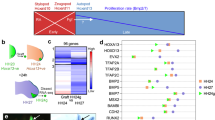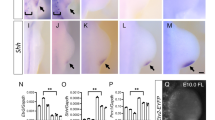Abstract
SUBDIVISION of the limb primordia into compartments initiates pattern formation in the developing limbs1,2. Interaction between distinctly specific cells in adjacent compartments leads to localized expression of the secreted signalling molecules Wingless (Wg) or Decapentaplegic (Dpp), which in turn organize pattern and control growth of the limbs3–8. The homeobox gene engrailed has been implicated in specification of posterior cell fate 9–12, whereas the LIM/homeobox gene, apterous, specifies dorsal fate3. Removing apterous activity causes a complete transformation from dorsal to ventral fate and leads to the formation of an ectopic dorsal-ventral boundary organizer3,13. By contrast, removing engrailed activity causes incomplete morphological transformation from posterior to anterior fate in the wing10,14,15, and fails to produce an ectopic anterior–posterior organizer (reviewed in ref. 2). Complete transformation can only be effected by simultaneously eliminating activity of engrailed and its homologue invected16–18. Here we show that invected functions principally to specify posterior cell fate. Thus establishment of the anterior–posterior organizer and control of compartment identity are genetically distinguishable, and invected may perform a discrete subset of functions previously ascribed to engrailed.
This is a preview of subscription content, access via your institution
Access options
Subscribe to this journal
Receive 51 print issues and online access
$199.00 per year
only $3.90 per issue
Buy this article
- Purchase on Springer Link
- Instant access to full article PDF
Prices may be subject to local taxes which are calculated during checkout
Similar content being viewed by others
References
García-Bellido, A., Ripoll, P. & Morata, G. Nature new Biol. 245, 251–253 (1973).
Lawrence, P. A. & Morata, G. Cell 78, 181–189 (1994).
Diaz-Benjumea, F. J. & Cohen, S. M. Cell 75, 741–752 (1993).
Basler, K. & Struhl, G. Nature 368, 208–214 (1994).
Tabata, T. & Kornberg, T. Cell 76, 89–102 (1994).
Diaz-Benjumea, F. J., Cohen, B. & Cohen, S. M. Nature 372, 175–179 (1994).
Capdevila, J. & Guerrero, I. EMBO J. 13, 4459–4468 (1994).
Ingham, P. W. & Fietz, M. J. Curr. Biol. 5, 432–440 (1995).
García-Bellido, A. & Santamaria, P. Genetics 72, 87–104 (1972).
Morata, G. & Lawrence, P. A. Nature 255, 614–617 (1975).
Lawrence, P. A. & Morata, G. Devl Biol. 50, 321–337 (1976).
Kornberg, T., Siden, I., O'Farrell, P. & Simon, M. Cell 40, 45–53 (1985).
Williams, J. A., Paddock, S. W., Vorwerk, K. & Carroll, S. B. Nature 368, 299–305 (1994).
Lawrence, P. A. & Struhl, G. EMBO J. 7, 827–833 (1982).
Gubb, D. Wilhelm Roux Arch. dev. Biol. 194, 236–246 (1985).
Hidalgo, A. Curr. Biol. 4, 1087–1098 (1994).
Sanicola, M., Sekelsky, J., Elson, S. & Gelbart, W. M. Genetics 139, 745–756 (1995).
Tabata, T., Schwartz, C., Gustavson, E., Ali, Z, & Kornberg, T. B. Development (in the press).
Eker, R. Hereditas 12, 217–222 (1929).
Lepage, T., Cohen, S. M., Diaz-Benjumea, F. J. & Parkhurst, S. M. Nature 373, 711–715 (1995).
Serrano, N. et al. Development 121, 1691–1703 (1995).
Busturia, A. & Morata, G. Development 104, 713–720 (1988).
Wurst, W., Auerbach, A. B. & Joyner, A. L. Development 120, 2065–2075 (1994).
Patel, N. H. et al. Cell 58, 955–968 (1989).
Williams, J. A., Bell, J. B. & Carroll, S. B. Genes Dev. 5, 2481–2495 (1991).
Schwartz, C., Locke, J., Nishida, C. & Kornberg, T. B. Development 121, 1625–1635 (1995).
Blackman, R. K., Sanicola, M., Raftery, L. A., Gillevet, T. & Gelbart, W. M. Development 111, 657–665 (1991).
Lee, J. J., von Kessler, D. P., Parks, S. & Beachy, P. A. Cell 71, 33–50 (1992).
Brand, A. & Perrimon, N. Development 118, 401–415 (1993).
Poole, S. J., Kauvar, L. M., Drees, B. & Kornberg, T. Cell 40, 37–43 (1985).
Williams, J. A. et al. Genetics 125, 833–844 (1990).
Author information
Authors and Affiliations
Rights and permissions
About this article
Cite this article
Simmonds, A., Brook, W., Cohen, S. et al. Distinguishable functions for engrailed and Invected in anterior–posterior patterning in the Drosopila wing. Nature 376, 424–427 (1995). https://doi.org/10.1038/376424a0
Received:
Accepted:
Issue Date:
DOI: https://doi.org/10.1038/376424a0
Comments
By submitting a comment you agree to abide by our Terms and Community Guidelines. If you find something abusive or that does not comply with our terms or guidelines please flag it as inappropriate.



